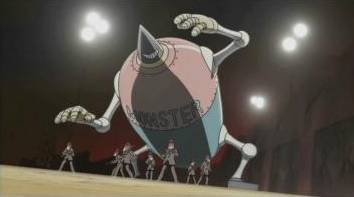|
Tetsujin
28 is a retelling of the classic "boy and his robot"
animé story. The original Tetsujin series – better
known as Gigantor in English – told the story of
Shotaro Kaneda, a young boy detective, who fights crime
in the year 2000 with the aid of his remote-controlled giant
robot, also named Shotaro. This version places the action
firmly in the 1950s, centering much of its background around
Japan's technological boom period directly after the Second
World War.

In
all other respects, Tetsujin 28 follows exactly the
same plot. Going by the opening sequence of the first episode
alone, casual viewers might think that they've stepped into
an 80s Saturday morning cartoon series – the precocious
young hero battles nondescript gangsters and, obviously,
saves the day. There's a thread of clear-cut "good guys
vs. bad guys" that runs through all of the episodes on the
disc, of which there are five:
1.
The Resurrection of Shotaro 2. No. 27 vs. No. 28 These
first two episodes detail the origin of the robot Tetsujin,
as well as introducing the key players Shotaro, Shikishima,
and the Murasame Brothers. A deadly relic from the war threatens
to fall on the recovering city of Tokyo, but it's what's
inside the missile that is truly deadly. Tetsujin rampages
through Tokyo, and it's left to Shikishima's new robot,
No. 27, to stop him. Meanwhile, the Murasame Brothers are
out for revenge, and Shotaro is on the case.
3.
The Arrival of Monster Robot A trail of clues in an
abandoned research facility leads Shotaro to Dr. Franken,
a mad genius behind several wartime experiments – and a
mysterious robot lurking in the darkness.
4.
The Other Tetsujin Project Shotaro continues to chase
down Dr. Franken, but now with the added problem of Kenji
Murasame, recently escaped from prison with the aid of a
new robot.
5.
Tetsujin vs. Black Ox The hunt for Dr. Franken goes
on. Some arms of the government want Franken to continue
his experiments, and only Shotaro and Tetsujin stand in
his way.
The
series is produced in a faux-retro style, intentionally
similar to the original Tetsujin series. The character's
wide-eyed, rounded faces remind me mostly of the Tintin cartoon series, and although it's a nice homage to the original,
it feels out of place in a modern animé series. While
obviously the quality of the animation has been improved,
notably with the addition of CGI effects, the overall style
strikes me as something best used in kids' TV, and gives
an unwelcome air of simplicity and childishness to what
is trying to be a serious, modern animé.
However,
the plot – as mentioned above, a carbon copy of the original
– has been left exactly as it is. There's no real mystery
to why the characters are doing what they're doing; no characterisation
except for "he's good, he's bad, they're vaguely mysterious".
Even the major villain of this volume, Dr. Franken, isn't
original – his story and basic character having been (obviously)
taken from Mary Shelley's Frankenstein. There's a
decent-enough prologue to the first few episodes that feels
a lot like a lesson in post-war Japanese history, but adds
in the series' own fictional "giant robot development" plotlines.

Soundwise,
the English dubbing is excellent; I have no complaints.
The opening theme (performed by a Japanese men's choir)
is a rousing anthem to the series, and is reprised throughout
the episodes – notably as a downbeat track using only a
harmonica. Sound effects are well-volumed; once again, no
specific complaints here.
I
was disappointed with Tetsujin 28, mostly because
I was expecting more from it than a rehash of an old plot
dressed up in new CGI. If you enjoy mecha-oriented animé
and manga (or a fan of the original looking for a nostalgia
kick), you'll most likely lap this up, but I can certainly
see how others would be disappointed.
The
anamorphic 16:9 picture is clean and boasts reasonable detail
and contrast, and seems right for the tetsujin 28's
comic-book look. There are some minor compression artefacts
visible in large areas of grey, but this is infrequent.
The
usual three options – stereo 2.0, surround 5.1 and DTS –
are all available in English or Japanese. The 5.1 and DTS
are virtually identical, both being fuller, louder and more
widely spread than the stereo track, although neither are spectacular. The stereo track does have a little
more subtlety, though. The surrounds are not used with any
purpose, just to expand the sound effects and music.
The
disc is badly let down by the complete lack of unique extra
features. All you get is a textless opening,
Tetsujin 28's trailer, and the usual Manga collection
of other trailers: Ghost in the Shell, Art of
Animé, etc.
The
disc menu also suffers from one of those "option carousel"-style
displays, where you must wait for the option you want to
come to the front before you can select it.
|